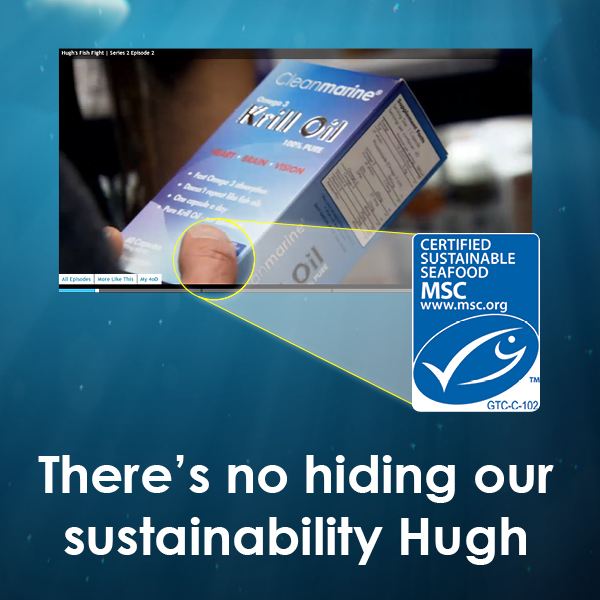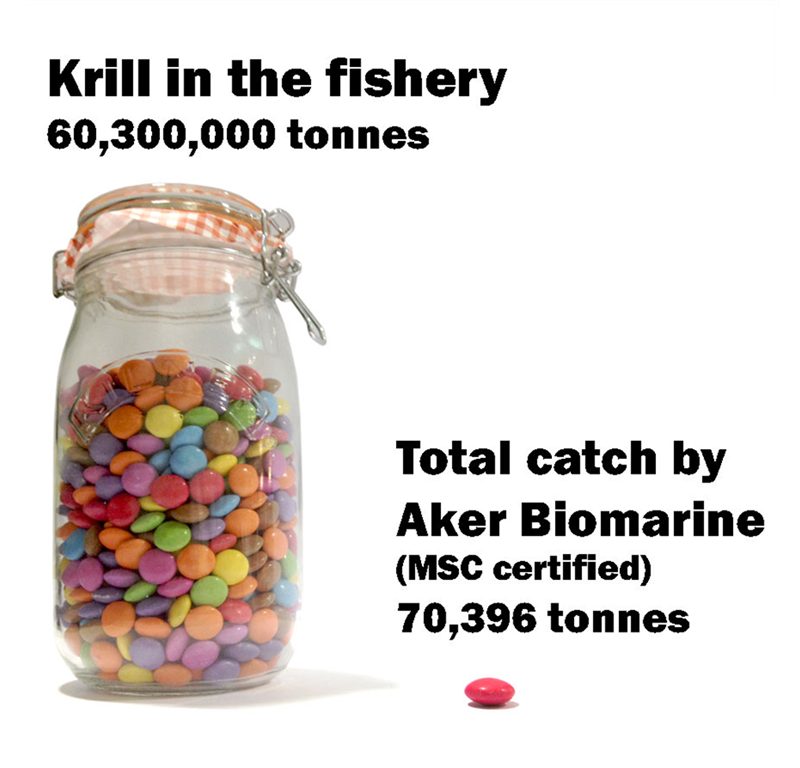Aker BioMarine’s sustainable approach to krill fishing featured on Hugh’s Fish Fight

Aker BioMarine, the leading Norwegian krill fishing company that supplies krill oil to Cleanmarine was featured on Hugh’s Fish Fight (Channel 4, Thursday February 21st at 21:00 GMT).
In search of practical examples of sustainable fishing, Hugh and the Fish Fight team journeyed to the Southern Ocean to join one of Aker BioMarine’s high-tech vessels, the Saga Sea, to witness first-hand how Aker BioMarine’s sustainable fishing techniques catch and process krill without by-catch or wastage. Aker BioMarine is the only krill fishery certified as sustainable by the Marine Stewardship Council (MSC).
Krill are tiny crustaceans living in the Antarctic and a food source for a variety of Antarctic marine life including whales, seals, and penguins. It is fished for the production of krill meal and krill oil, which in turn is used for animal or aquaculture feed and for direct human consumption through health products and omega-3 supplements. The Omega 3 from Krill is in a superior form to fish oil and absorbs more efficiently bringing with it similar to superior benefits but from smaller capsules.
In the programme, we saw Hugh visiting Revital to find out about the health benefits of krill oil and profiled Cleanmarine Krill Oil, before he joined the Saga Sea in the Antarctic to see how krill is fished.
Hugh raised concern about the volume of krill being fished and therefore its sustainability and also expressed an eagerness to extend the Marine Protection Zones around South Georgia.
Webjørn Eikrem, EVP at Aker BioMarine, says:
“Consumer demand for krill oil has risen steadily since 2009 and Aker BioMarine has developed a sustainable solution in the form of Eco-HarvestingTM . As the leading and only MSC certified krill fishery, we have a great responsibility to safeguard this resource. That’s why we work closely with the industry, regulators, scientists and NGOs, to ensure a sustainable supply of krill-based products, not only today but for years to come. As part of our intention to make the krill fishing industry more transparent and open, we were delighted to welcome Hugh Fearnley-Whittingstall and the Fish Fight team aboard. It was an opportunity for them to see the benefits to food safety and sound stock management of monitoring the whole supply chain, from catch to customer, and how a responsible fishery can assist in the collection of scientific data to help protect the krill biomass in Antarctica.”
As was indicated in the programme, the krill fishery is sustainable and this is reflected in our certification by the Marine Stewardship Council – recognised by the WWF as being the foremost certification body for assessing sustainability of fisheries. Something Hugh seemed to do his best to hide from his viewers with his thumb!
Current Sustainability of the krill fishery
Hugh quoted that that total biomass of Antarctic krill is estimated to be around 600 million tons
In the area approved for krill fishing (“Area 48”), the total krill biomass is estimated at over 60 million tons.
In 2012 the total krill catch was 0.157 million tons (0.26 % of the biomass in just Area 48).

Future Sustainability of the krill fishery
Hugh implies that there could well be a "Gold-Rush" to Antarctica in search of krill. But there are safeguards to ensure that this does not happen. The Commission for the Conservation of Antarctic Marine Living Resources, CCAMLR was set up in 1982 precisely to forestall the unregulated expansion of any fishery – for krill or fish – in the Southern Ocean. It is a legally-binding international convention between 25 countries to ensure the conservation of the Antarctic’s marine ecosystems. Most of the large fishing countries are full members of CCAMLR including all those fishing for krill – Chile, China, Japan, Korea and Norway. The Commission doesn’t prevent fishing, provided it is carried out in a sustainable way. To read more on how the fishery is protected against a "Gold-Rush" visit the MSC blog article here
The Commission sets sustainable catch quotas and Marine Protected Areas and Aker Biomarine not only work within these restrictions but work closely with CCAMLR as well as WWF-Norway to monitor fishing zones, krill numbers, predator foraging areas and other ecosystem markers to ensure the future sustainable growth of the fishery for all concerned including the fish and animals that depend upon krill for their survival.
To find out more about the sustainability of krill visit www.krillsustainability.com
For further information contact:
David Gunning
Marketing Manager
Cleanmarine Krill Oil
0113 388 5249
david@savant-health.com
About Cleanmarine Krill Oil
Cleanmarine Krill Oil is the UK's first and only Krill Oil certified by the Marine Stewardship Council as being fished from a sustainable and well managed fishery.
Cleanmarine Krill Oil provides the next generation of Omega 3 supplement providing EPA and DHA in a superior form to that of fish oils and in a convenient, small one a day capsule.
Whether you supplement your diet with Omega 3 for heart health, brain function, vision or joint health or are an athlete seeking to obtain superior recovery and mental alertness Cleanmarine® Krill Oil is the smart choice for Omega 3
~ Better Omega 3 absorption and more effective than fish oils
~ Sustainably and ethically fished
~ No fishy repeat!
Tags:



